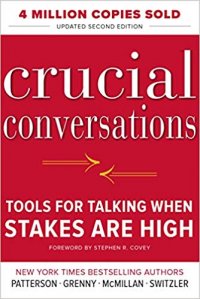You may also like

Crucial Conversations
by Patterson, Grenny, McMillan, and Switzler
Creativity, Inc.
by Ed Catmull & Amy Wallace






by Steven D. Levitt and Stephen J. Dubner
Freakonomics is the first book co-authored by this journalist and economist duo. It looks for unlikely answers to existing phenomenon, covering topics like incentive systems, cheating, the power of information, cause and effect versus correlations, and many others. It doesn’t go in to great detail on how they prove their findings like a research journal article would, but does lightly summarize the methodologies used. You won’t be able to utilize these methods just from reading Freakonomics, but it could very well open your mind to new ways of thinking and challenging you previously existing assumption.
If nothing else, this book is INTERESTING! I had a really hard time trying to summarize it, but I found most of the chapters to be quite entertaining, while occasionally getting too detailed. The authors, a duo made up of an economist and a journalist, are driven by a desire to tell stories, using economic data analysis and quirky anecdotes along the way. Freakonomics covers a variety of themes including: • Incentives and cheating • The power of information • Conventional wisdom
According to Levitt and Dubner, most of economics is studying incentive – identifying how to urge people to either do more of a good thing or less of a bad thing. We try to manipulate incentives (think fines, taxes, rewards, etc.), but the most interesting incentives are the ones that have unforeseen and unintentional consequences. Freakonomics looks directly at incentives and cheating in two professions: teachers and sumo wrestlers.
Students have always had the incentive to cheat, but the concept of tying school funding and teacher bonuses to standardized test results has incentivized teachers to cheat as well. Freakonomics describes:
I’d be interested to see Levitt and Dubner take the next step and identify a better incentive system. Should schools that score low receive more funding rather than less? Before the authors can exhaust the teacher cheating topic, they move on to discussing the similarities in sumo wrestling.
Sumo wrestling is the national sport in Japan, a country with tremendous pride and tradition. Would we ever expect such a proud population to tolerate cheating in their favorite pastime and would that be enough to prevent it? The authors describe how they uncover the rampant match fixing in the sumo wrestling community and how the ranking system incentives them to do so.
Information can give power and information can take it away. Where information gives a certain amount of power to realtors, information is what eventually lead to the downfall of the KKK. Freakonomics dives into both.
Most people believe that their realtor acts in their best interest. But do they? Going back to the idea of incentives, are realtors incentivized to do so? In short, not at all – they work on percentages and if you sell your house for an extra $10,000, which is a huge impact to you, they receive only an extra ~$150, almost nothing compared to the earnings for the sale. So then why do we use them? Because they are experts and they know more about the process of buying and selling houses than everyone else. Imagine a world where we all know everything about selling a home, would realtors have any power then? And that’s exactly how KKK lost their power. The authors tell the story of how the KKK lost most of their sympathizers and influence at the peak of their strength in the 1940s due to their stories being told through public radio programs, the main source of in-home entertainment at the time. Information shared with the masses is a powerful enabler and the authors explain how new technologies developed in the late 1990s helped the spread of information and what impact it had on the status quo of several industries.
Conventional wisdom led most experts in the 90s to claim that the decrease in crime rates in New York City and other metros were caused by 1) the local law enforcement using new technologies and new policing tactics, 2) hiring more police officers, 3) the aging population, 4) the improvement to the economy, among many others. They looked at what were high crime rates, then identified that actions were taken in hopes of lowering the crime rate, and then assumed those actions were what actually caused it. The authors debunk each of these explanations by analyzing the crime rates of cities that did not experience those changes. Crime went down everywhere in the 90s and we can’t let the big cities take the credit. So, what did they deem the true cause of the decrease? What was common among all areas where crime went down? Abortion was legalized ~15-20 years prior and the authors go into detail on why this is the true cause of the decrease in crime and how they prove it.
In their assessment of crime rates, the authors challenged (and disproved) conventional wisdom and tested their theory until they found an answer that made sense. They prove that you can do this with almost any topic by taking the same thought process and applying it. Take parenting, for example. Which parenting activities are most likely to lead a child to have a successful life? How much does their name matter? We live so much of our lives doing X because we think it’ll directly lead to Y, but is Y really dependent on X? By challenging conventional wisdom, we can fix those misassumptions and find the real X that causes Y.
Some other key Takeaways and Quotes
The journey of reading Freakonomics is far more rewarding than the simplified summaries described above. I thoroughly enjoyed being introduced to each new idea in this book and would highly recommend it to any one that needs a better understanding of how to identify cause and effect or a nudge with how to begin thinking outside the proverbial box.


